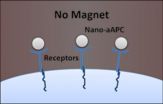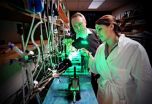(Press-News.org) Researchers have devised a way of making tiny holes of controllable size in sheets of graphene, a development that could lead to ultrathin filters for improved desalination or water purification.
The team of researchers at MIT, Oak Ridge National Laboratory, and in Saudi Arabia succeeded in creating subnanoscale pores in a sheet of the one-atom-thick material, which is one of the strongest materials known. Their findings are published in the journal Nano Letters.
The concept of using graphene, perforated by nanoscale pores, as a filter in desalination has been proposed and analyzed by other MIT researchers. The new work, led by graduate student Sean O'Hern and associate professor of mechanical engineering Rohit Karnik, is the first step toward actual production of such a graphene filter.
Making these minuscule holes in graphene — a hexagonal array of carbon atoms, like atomic-scale chicken wire — occurs in a two-stage process. First, the graphene is bombarded with gallium ions, which disrupt the carbon bonds. Then, the graphene is etched with an oxidizing solution that reacts strongly with the disrupted bonds — producing a hole at each spot where the gallium ions struck. By controlling how long the graphene sheet is left in the oxidizing solution, the MIT researchers can control the average size of the pores.
A big limitation in existing nanofiltration and reverse-osmosis desalination plants, which use filters to separate salt from seawater, is their low permeability: Water flows very slowly through them. The graphene filters, being much thinner, yet very strong, can sustain a much higher flow. "We've developed the first membrane that consists of a high density of subnanometer-scale pores in an atomically thin, single sheet of graphene," O'Hern says.
For efficient desalination, a membrane must demonstrate "a high rejection rate of salt, yet a high flow rate of water," he adds. One way of doing that is decreasing the membrane's thickness, but this quickly renders conventional polymer-based membranes too weak to sustain the water pressure, or too ineffective at rejecting salt, he explains.
With graphene membranes, it becomes simply a matter of controlling the size of the pores, making them "larger than water molecules, but smaller than everything else," O'Hern says — whether salt, impurities, or particular kinds of biochemical molecules.
The permeability of such graphene filters, according to computer simulations, could be 50 times greater than that of conventional membranes, as demonstrated earlier by a team of MIT researchers led by graduate student David Cohen-Tanugi of the Department of Materials Science and Engineering. But producing such filters with controlled pore sizes has remained a challenge. The new work, O'Hern says, demonstrates a method for actually producing such material with dense concentrations of nanometer-scale holes over large areas.
"We bombard the graphene with gallium ions at high energy," O'Hern says. "That creates defects in the graphene structure, and these defects are more chemically reactive." When the material is bathed in a reactive oxidant solution, the oxidant "preferentially attacks the defects," and etches away many holes of roughly similar size. O'Hern and his co-authors were able to produce a membrane with 5 trillion pores per square centimeter, well suited to use for filtration. "To better understand how small and dense these graphene pores are, if our graphene membrane were to be magnified about a million times, the pores would be less than 1 millimeter in size, spaced about 4 millimeters apart, and span over 38 square miles, an area roughly half the size of Boston," O'Hern says.
With this technique, the researchers were able to control the filtration properties of a single, centimeter-sized sheet of graphene: Without etching, no salt flowed through the defects formed by gallium ions. With just a little etching, the membranes started allowing positive salt ions to flow through. With further etching, the membranes allowed both positive and negative salt ions to flow through, but blocked the flow of larger organic molecules. With even more etching, the pores were large enough to allow everything to go through.
Scaling up the process to produce useful sheets of the permeable graphene, while maintaining control over the pore sizes, will require further research, O'Hern says.
Karnik says that such membranes, depending on their pore size, could find various applications. Desalination and nanofiltration may be the most demanding, since the membranes required for these plants would be very large. But for other purposes, such as selective filtration of molecules — for example, removal of unreacted reagents from DNA — even the very small filters produced so far might be useful.
"For biofiltration, size or cost are not as critical," Karnik says. "For those applications, the current scale is suitable."
INFORMATION:
The work also included Jing Kong, the ITT Career Development Associate Professor of Electrical Engineering; MIT graduate students Michael Boutilier and Yi Song; researcher Juan-Carlos Idrobo of the Oak Ridge National Laboratory; and professors Tahar Laoui and Muataz Atieh of the King Fahd University of Petroleum and Minerals (KFUPM). The project received support from the Center for Clean Water and Clean Energy at MIT and KFUPM and the U.S. Department of Energy.
Written by David L. Chandler, MIT News Office
Technique to create holes in graphene could improve water filters, desalination
New technique developed at MIT produces highly selective filter materials, could lead to more efficient desalination
2014-02-25
ELSE PRESS RELEASES FROM THIS DATE:
Report details multiple commercial uses of wireless sensor networks
2014-02-25
ATHENS, GA--Managing the quality and quantity of freshwater resources is one of the most serious environmental challenges of the 21st century. Global population growth and increasing urbanization have resulted in increased competition for water resources among domestic, industrial, and agricultural users. Challenged to find ways to manage irrigation needs while recognizing the limitations of freshwater resources, many commercial horticulture operations are showing increased interest in the use of wireless sensor networks (WSN)--technology designed to both monitor and control ...
Analysis: 32 years of US filicide arrests
2014-02-25
PROVIDENCE, R.I. [Brown University] — Instances in which parents kill their children may seem so horrifying and tragic that they defy explanation. Published scientific and medical research, meanwhile, doesn't offer much epidemiological context to help people understand patterns among such heinous crimes. A paper in the March edition of the journal Forensic Science International provides the first comprehensive statistical analysis of filicide in the United States, drawing on 32 years of data on more than 94,000 arrests. The study also explores possible underlying psychiatric ...
CWRU researchers find byproducts of bacteria-causing gum disease incite oral cancer growth
2014-02-25
Researchers from Case Western Reserve University have discovered how byproducts in the form of small fatty acids from two bacteria prevalent in gum disease incite the growth of deadly Kaposi's sarcoma-related (KS) lesions and tumors in the mouth.
The discovery could lead to early saliva testing for the bacteria, which, if found, could be treated and monitored for signs of cancer and before it develops into a malignancy, researchers say.
"These new findings provide one of the first looks at how the periodontal bacteria create a unique microenvironment in the oral cavity ...
Eliminating maternal mortality could extend life expectancy in reproductive ages
2014-02-25
Maternal death rates represent the single largest health discrepancy between developed and developing populations, with nearly all - over 99% -- maternal deaths worldwide occurring in developing countries and over half of them in sub-Saharan Africa countries. Eliminating maternal mortality, which is defined as the deaths related to pregnancy, would result in a gain of over a half year (0.6 years) in life expectancy worldwide, according to a new study by researchers at Johns Hopkins Bloomberg School of Public Health. The study is published February 13 in PLOS ONE.
Over ...
Magnetic medicine
2014-02-25
Using tiny particles designed to target cancer-fighting immune cells, Johns Hopkins researchers have trained the immune systems of mice to fight melanoma, a deadly skin cancer. The experiments, described on the website of ACS Nano on February 24, represent a significant step toward using nanoparticles and magnetism to treat a variety of conditions, the researchers say.
"Size was key to this experiment," says Jonathan Schneck, M.D., Ph.D., a professor of pathology, medicine and oncology at the Johns Hopkins University School of Medicine's Institute for Cell Engineering. ...
3-D printer creates transformative device for heart treatment
2014-02-25
Igor Efimov, PhD, at the School of Engineering & Applied Science at Washington University in St. Louis and an international team of biomedical engineers and materials scientists have created a 3-D elastic membrane made of a soft, flexible, silicon material that is precisely shaped to match the heart's epicardium, or the outer layer of the wall of the heart. Current technology is two-dimensional and cannot cover the full surface of the epicardium or maintain reliable contact for continual use without sutures or adhesives.
The team can then print tiny sensors onto the membrane ...
Vitamin A may help boost immune system to fight tuberculosis
2014-02-25
Tuberculosis is a major global problem, affecting 2 billion people worldwide and causing an estimated 2 million deaths annually. Western countries are once again tackling the disease, with recent outbreaks in Los Angeles and London.
The rise of drug-resistant TB, called a "ticking time bomb" by the World Health Organization, and the high cost of fighting the disease highlight the need for new approaches to treatment.
In findings published in the March 1 issue of the Journal of Immunology, UCLA researchers investigating the role of nutrients in helping the immune ...
Discovery of a 'conductor' in muscle development
2014-02-25
Montréal, February 25, 2014 – A team led by Jean-François Côté, researcher at the IRCM, identified a ''conductor'' in the development of muscle tissue. The discovery, published online yesterday by the scientific journal Proceedings of the National Academy of Sciences (PNAS), could have an important impact on the treatment of muscular diseases such as myopathies and muscular dystrophies.
"For several years, we have been studying myogenesis, a process by which muscles are formed during embryonic development," says Jean-François Côté, PhD, Director of the Cytoskeletal Organization ...
Psychological side-effects of anti-depressants worse than thought
2014-02-25
LIVERPOOL, UK – 26 February 2014: A University of Liverpool researcher has shown that thoughts of suicide, sexual difficulties and emotional numbness as a result of anti-depressants may be more widespread than previously thought.
In a survey of 1,829 people who had been prescribed anti-depressants, the researchers found large numbers of people – over half in some cases – reporting on psychological problems due to their medication, which has led to growing concerns about the scale of the problem of over-prescription of these drugs.
Psychologist and lead researcher, Professor ...
New record set for data-transfer speeds
2014-02-25
WASHINGTON, Feb. 25, 2014 – Researchers at IBM have set a new record for data transmission over a multimode optical fiber, a type of cable that is typically used to connect nearby computers within a single building or on a campus. The achievement demonstrated that the standard, existing technology for sending data over short distances should be able to meet the growing needs of servers, data centers and supercomputers through the end of this decade, the researchers said.
Sending data at a rate of 64 gigabits per second (Gb/s) over a cable 57 meters long using a type ...
LAST 30 PRESS RELEASES:
Heart-brain connection: international study reveals the role of the vagus nerve in keeping the heart young
Researchers identify Rb1 as a predictive biomarker for a new therapeutic strategy in some breast cancers
Survey reveals ethical gaps slowing AI adoption in pediatric surgery
Stimulant ADHD medications work differently than thought
AI overestimates how smart people are, according to HSE economists
HSE researchers create genome-wide map of quadruplexes
Scientists boost cell "powerhouses" to burn more calories
Automatic label checking: The missing step in making reliable medical AI
Low daily alcohol intake linked to 50% heightened mouth cancer risk in India
American Meteorological Society announces Rick Spinrad as 2026 President-Elect
Biomass-based carbon capture spotlighted in newly released global climate webinar recording
Illuminating invisible nano pollutants: advanced bioimaging tracks the full journey of emerging nanoscale contaminants in living systems
How does age affect recovery from spinal cord injury?
Novel AI tool offers prognosis for patients with head and neck cancer
Fathers’ microplastic exposure tied to their children’s metabolic problems
Research validates laboratory model for studying high-grade serous ovarian cancer
SIR 2026 delivers transformative breakthroughs in minimally invasive medicine to improve patient care
Stem Cell Reports most downloaded papers of 2025 highlight the breadth and impact of stem cell research
Oxford-led study estimates NHS spends around 3% of its primary and secondary care budget on the health impacts of heat and cold in England
A researcher’s long quest leads to a smart composite breakthrough
Urban wild bees act as “microbial sensors” of city health.
New study finds where you live affects recovery after a hip fracture
Forecasting the impact of fully automated vehicle adoption on US road traffic injuries
Alcohol-related hospitalizations from 2016 to 2022
Semaglutide and hospitalizations in patients with obesity and established cardiovascular disease
Researchers ‘listen in’ to embryo-mother interactions during implantation using a culture system replicating the womb lining
How changing your diet could help save the world
How to make AI truly scalable and reliable for real-time traffic assignment?
Beyond fragmented markets: A new framework for efficient and stable ride-pooling
Can shape priors make road perception more reliable for autonomous driving?
[Press-News.org] Technique to create holes in graphene could improve water filters, desalinationNew technique developed at MIT produces highly selective filter materials, could lead to more efficient desalination


